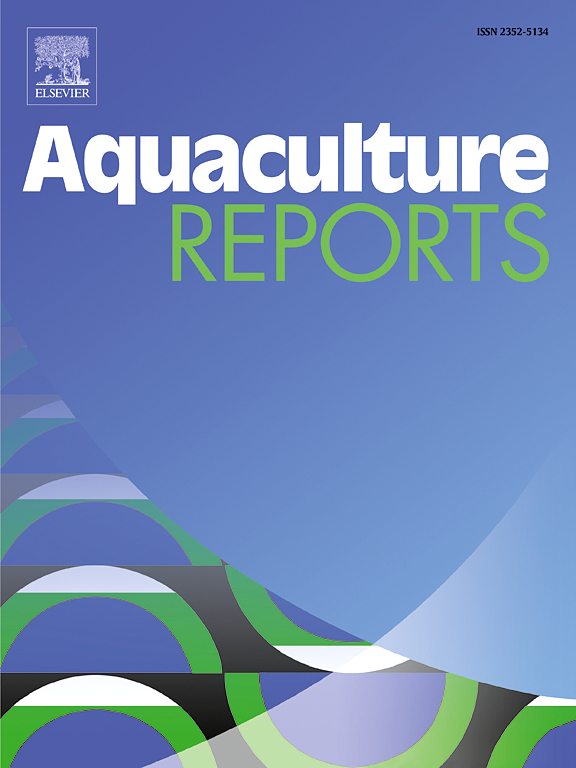平衡作用:胆固醇和磷脂如何影响副螯蟹幼体的生长和脂质代谢
IF 3.2
2区 农林科学
Q1 FISHERIES
引用次数: 0
摘要
设计了一项 2 × 3 双因素实验,以评估日粮中胆固醇(CHO)和磷脂(PLs)对早期幼体泥蟹(0.01 g 蟹-1)生长和脂质代谢的影响。实验日粮设计了两种胆固醇水平:0.40 %(LCH)和 0.80 %(HCH),三种磷脂水平:1.80 %(LPL)、2.50 %(MPL)和 3.20 %(HPL)。为期 58 天的养殖试验表明,LCH-HPL 组泥蟹的生长性能最好,最终体重、增重和特定生长率最高。在全身组成方面,膳食 PLs 增加了 LCH 组的总胆固醇(T-CHO)、PLs、甘油三酯(TG)和粗脂肪含量。与LCH组相比,HCH组泥蟹的饱和脂肪酸比例较高,单不饱和脂肪酸比例较低,固醇调节元件结合蛋白1c(srebp-1c)和脂肪酸合成酶(fas)的基因表达量增加。随着膳食PL的增加,LCH组泥蟹的srebp-1c、fas、极长链脂肪酸伸长蛋白4(elovl4)、elovl6和Δ9-脂肪酸脱饱和酶(Δ9-fad)等基因的表达出现上调。在 HCH 组中,膳食中 PLs 的升高导致脂肪酸结合蛋白(fabp)基因表达下调。此外,高水平的膳食 CHO 和 PLs(HCH-HPL)抑制了泥蟹的过氧化氢酶活性,导致丙二醛含量显著增加。相关分析表明,膳食 CHO 与长链多不饱和脂肪酸合成基因的表达呈正相关,膳食 PLs 与泥蟹全身脂质含量呈正相关。此外,研究还发现泥蟹的生长性能与全身粗蛋白、粗脂肪和抗氧化能力之间存在正相关。本文章由计算机程序翻译,如有差异,请以英文原文为准。
Balancing act: How cholesterol and phospholipids influence juvenile mud crab Scylla paramamosain growth and lipid metabolism
A 2 × 3 two-factor experiment was designed to assess the effects of dietary cholesterol (CHO) and phospholipids (PLs) on growth and lipid metabolism in early juvenile mud crabs (0.01 g crab−1). The experimental diets were designed with two CHO levels: 0.40 % (LCH) and 0.80 % (HCH), and three PLs levels: 1.80 % (LPL), 2.50 % (MPL), and 3.20 % (HPL). The 58-day aquaculture trial demonstrated that the LCH-HPL group achieved the best growth performance in mud crabs, characterized by the highest final body weight, weight gain, and specific growth rate. Regarding whole-body composition, dietary PLs increased total cholesterol (T-CHO), PLs, triglyceride (TG), and crude lipid content in the LCH groups. Mud crabs in the HCH groups had a higher proportion of saturated fatty acids, a lower proportion of monounsaturated fatty acids, and increased gene expression of sterol regulatory element binding protein 1c (srebp-1c) and fatty acid synthase (fas) compared to those in the LCH groups. As the dietary PLs increased, mud crabs in the LCH groups exhibited up-regulation in the expression of genes, including srebp-1c, fas, elongation of very long-chain fatty acid protein 4 (elovl4), elovl6, and Δ9-fatty acid desaturase (Δ9-fad). In the HCH groups, elevated dietary PLs resulted in the down-regulation of fatty acid binding protein (fabp) gene expression. In addition, high levels of dietary CHO and PLs (HCH-HPL) inhibited the catalase activity of mud crabs, resulting in a significant increase in the malondialdehyde content. Correlation analysis revealed that dietary CHO was positively correlated with the expression of long-chain polyunsaturated fatty acids synthesizing genes, and dietary PLs were positively correlated with the whole-body lipid content of mud crabs. Additionally, a positive correlation was found between the growth performance and whole-body content of crude protein, crude lipid, and antioxidant capacity in mud crabs.
求助全文
通过发布文献求助,成功后即可免费获取论文全文。
去求助
来源期刊

Aquaculture Reports
Agricultural and Biological Sciences-Animal Science and Zoology
CiteScore
5.90
自引率
8.10%
发文量
469
审稿时长
77 days
期刊介绍:
Aquaculture Reports will publish original research papers and reviews documenting outstanding science with a regional context and focus, answering the need for high quality information on novel species, systems and regions in emerging areas of aquaculture research and development, such as integrated multi-trophic aquaculture, urban aquaculture, ornamental, unfed aquaculture, offshore aquaculture and others. Papers having industry research as priority and encompassing product development research or current industry practice are encouraged.
 求助内容:
求助内容: 应助结果提醒方式:
应助结果提醒方式:


